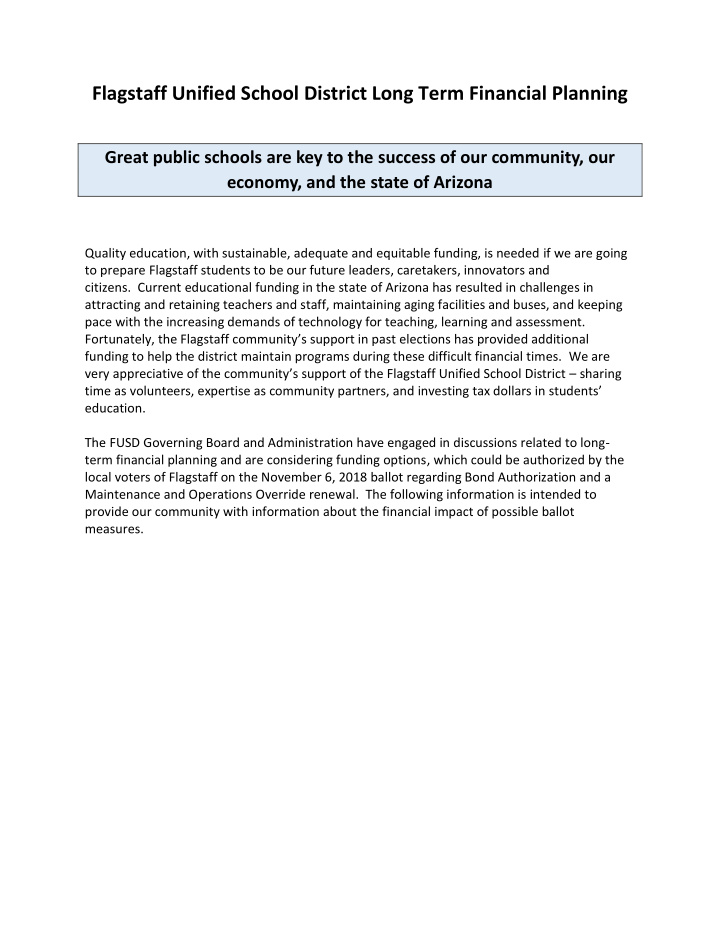



Flagstaff Unified School District Long Term Financial Planning Great public schools are key to the success of our community, our economy, and the state of Arizona Quality education, with sustainable, adequate and equitable funding, is needed if we are going to prepare Flagstaff students to be our future leaders, caretakers, innovators and citizens. Current educational funding in the state of Arizona has resulted in challenges in attracting and retaining teachers and staff, maintaining aging facilities and buses, and keeping pace with the increasing demands of technology for teaching, learning and assessment. Fortunately, the Flagstaff comm unity’s support in past elections has provided additional funding to help the district maintain programs during these difficult financial times. We are very appreciative of the community’s support of the Flagstaff Unified School District – sharing time as volunteers, expertise as community partners, and investing tax dollars in students’ education. The FUSD Governing Board and Administration have engaged in discussions related to long- term financial planning and are considering funding options, which could be authorized by the local voters of Flagstaff on the November 6, 2018 ballot regarding Bond Authorization and a Maintenance and Operations Override renewal. The following information is intended to provide our community with information about the financial impact of possible ballot measures.
The primary budgets for Arizona school districts are Maintenance and Operations (M&O) and Capital Outlay. Capital Outlay is sometimes called District Additional Assistance, or Unrestricted Capital. The M&O budget for FUSD currently stands at $67,976,207. This budget funds general operating expenses for the District for the current year including, but not limited to, the categories listed in the left hand column of the table above. Included in the M&O Budget is $8,079,559 authorized by District voters as an Override. Override, in this sense, means “an increase on a budget.” The District Capital Outlay Budget is calculated separately from the M&O Budget. Capital Outlay supports the purchase of assets that generally last beyond one school year. Categories supported by Capital Outlay dollars are listed in the right hand column of the table above. The Capital Outlay annual allocation for FUSD is currently $558,151. In addition to these funds, FUSD currently uses Bond Proceeds authorized by District voters in 2012. Certain categories of Capital Outlay cannot be supported by Bond Proceeds and these categories are shown in red above.
State support of capital upkeep for Arizona School Districts has diminished greatly since 2007. At that time the District received monies specifically for three general priorities shown in the bar graph above. Unrestricted Capital (green bar segments) was discussed above and the current capital budget is made up entirely from these dollars. Soft Capital (yellow bar segments) funds the same things as Unrestricted Capital, only must be used in the classroom. This program has not been funded since the 2012-2013 school year. Building Renewal (burnt orange bar segments) were born from a ruling of the Arizona Superior Court in 1996 that the Arizona Public School Capital funding mechanism violated the “general and uniform” clause of the Arizona Constitution. The result in 1998 was a program called Students FIRST. Part of that program included funding for Building Renewal (maintaining buildings to a standard). This program has not been funded since the 2007-2008 school year. Total state funding for capital expenditures at FUSD has been reduced by over $30,000,000 since 2007. Community support for FUSD capital initiatives has remained strong through this period, authorizing two bond programs and a five year capital override all totaling $84,890,000. FUSD currently has about $4,000,000 remaining from the 2012 Bond Authorization.
Before reductions to State funding of District capital initiatives began in earnest, districts tended to use Bond Proceeds for expenditures related to new facilities or for major renovations of facilities. State funding was sufficient to maintain current curriculum, provide a technology program, and maintain a life cycle replacement program for things like HVAC and water heaters. Today these things would not be possible without voter approved funding. It is hard to picture what FUSD facilities would look like today without that support. The “Bond Expenditures 2018” column in the table above indicates generally how the 2012 Bond Authorization has been used. FUSD Administration has recently procured a thorough assessment of all facilities to use as a guide for long term financial planning. The cost of all needs identified in the assessment exceeds what the District will ask the community to fund, but will be very useful in prioritizing needs and ensuring efficient and effective uses of any capital funding.
The table above indicates the current allocation of the FUSD M&O Budget. Note that 82.8% of District M&O funding is used for salaries and benefits for the great majority of FUSD staff.
As mentioned earlier, FUSD is supported by an M&O Override consisting of 15% of the District annual state allocation of M&O dollars. The current annual value of that override is just over $8,000,000. Some facts about the FUSD Override are shown above.
Override dollars are accounted for as part of the M&O Budget. FUSD uses these funds to maintain several programs that are not specifically funded or required by the State of Arizona. The FUSD M&O Override was approved by voters in 2014. Should that override not be renewed, it will begin to phase out for the 2020-2021 school year. The result would be a budget reduction of $2,700,000 for each of three consecutive years, resulting in a total reduction of $8,100,000 at year three.
Recommend
More recommend